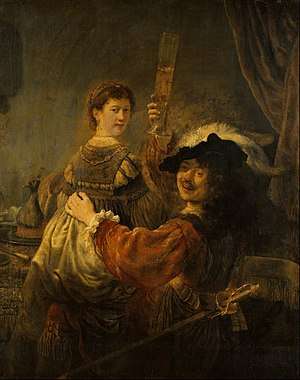The Prodigal Son in the Brothel
The Prodigal Son in the Brothel or The Prodigal Son in the Tavern or Rembrandt and Saskia in the parable of the prodigal son (German: Rembrandt und Saskia im Gleichnis vom verlorenen Sohn)[1] is a painting by the Dutch master Rembrandt. It is housed in the Gemäldegalerie Alte Meister of Dresden, Germany. It is signed "REMBRANDT F.".
| The Prodigal Son in the Brothel | |
|---|---|
 | |
| Artist | Rembrandt |
| Year | c. 1637 |
| Medium | Oil on canvas |
| Dimensions | 161 cm × 131 cm (63 in × 52 in) |
| Location | Gemäldegalerie Alte Meister, Dresden |
It portrays two people who had been identified as Rembrandt himself and his wife Saskia. In the Protestant contemporary world, the theme of the prodigal son was a frequent subject for works of art due to its moral background. Rembrandt himself painted a Return of the Prodigal Son in 1669.
The left side of the canvas was cut, perhaps by the artist himself, to remove secondary characters and focus the observer's attention on the main theme.
Painting materials
The pigment analysis[2] shows Rembrandt's choice of the usual baroque pigments such as red ochre, lead-tin-yellow, madder lake and smalt and also his elaborate multilayer painting technique.[3]
Sources
- D'Adda, Roberta (2006). Rembrandt. Milan: Skira.
External links
- The painting in the State Art Gallery in Dresden
- Rembrandt, Self-Portrait with Saskia (The Prodigal Son), ColourLex
Notes and references
- "Rembrandt und Saskia im Gleichnis vom verlorenen Sohn". SKD Online Collection. Retrieved 9 November 2018.
- Kühn, Hermann. ‘Untersuchungen zu den Pigmenten und Malgründen Rembrandts, durchgeführt an den Gemälden der Staatlichen Kunstsammlungen Dresden’, Maltechnik/Restauro, issue 4 (1977): 223-233
- Rembrandt, Self-Portrait with Saskia (The Prodigal Son), ColourLex